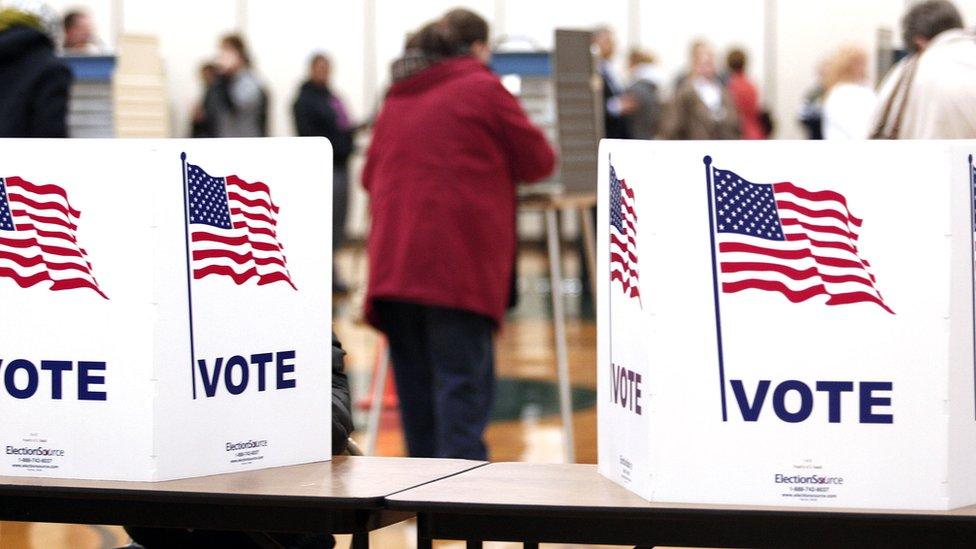US election 2016: All you need to know
- Published

The most powerful nation on earth is electing a new leader, with the impact felt across the globe. So how does the election work and how did we end up with Donald Trump and Hillary Clinton as the main candidates?
When the US picks its president, it is not only choosing a head of state but a head of government and a commander-in-chief of the largest military on the planet.
It's a big responsibility. So how does the process work?

Why is it Hillary Clinton v Donald Trump?
Katty Kay explains the long and complex process for picking a presidential nominee
The parties hold a series of primary elections in every state and overseas territory, starting in February, which determine who becomes the official presidential candidate.
The winner of each collects a number of "delegates" - party members with the power to vote for that candidate at the party conventions held in July, where candidates are formally confirmed.
The more state contests a candidate wins, the more delegates will be pledged to support them at the convention.
Democrat Hillary Clinton and Republican Donald Trump were the clear winners in 2016 and were officially nominated at their party's conventions in July.
They are two of the most unpopular candidates in modern American history.
How did we end up with two such unpopular candidates?
At the conventions, the parties also officially unveiled their vice-presidential picks - Senator Tim Kaine of Virginia for Mrs Clinton, and Indiana Governor Mike Pence for the Republicans.
Donald Trump - Living the American Dream
Who is the real Hillary Clinton?

What about the US Congress?
The Senate election results will also have a big impact. Republicans currently hold the majority in the 100-seat chamber. But 34 seats are up for grabs on 8 November. Democrats need a net gain of four seats to win control of the chamber if Hillary Clinton wins the presidency, as the US vice-president is automatically a member of the Senate, and five seats if Donald Trump is victorious.
In the House of Representatives, all 435 seats will be contested. Republicans have controlled it since the 2010 mid-terms, and currently hold 247 seats, compared to the Democrats' 188. This means the Democrats would need to win 30 to regain control. A swing of this size is widely considered unlikely, though they may narrow the Republican majority.

The big talking points of the presidential campaign
There has been a slew of controversies generated by Donald Trump, from the moment the New York businessman launched his campaign with the description of Mexican immigrants as "rapists and criminals". His candidacy has rarely gone a few weeks without sparking some uproar. He's waged wars of words with a judge, a Miss Universe, a Fox News anchor and the Muslim family of a fallen soldier. He's had to defend his refusal not to release his tax returns and the suggestion he has paid no federal income tax for 18 years, plus field questions surrounding his charitable foundation.
US presidential race goes down the drain
And Hillary Clinton has had her share of anxious moments too. The damage wrought by her private email arrangement to her reputation is thought to be significant, despite the FBI effectively closing the investigation in July and clearing Mrs Clinton of wrongdoing. Questions have been raised about the foreign donations to the Clinton Foundation. Mr Trump has also put the spotlight on the part she played in pushing back at the women who claimed to have affairs with her husband Bill. And Wikileaks has been revealing hacked emails that have laid bare some embarrassing conversations between members of her campaign team.
Clinton emails - what's it all about?

And the two big October surprises
The biggest bombshell to jolt the Trump campaign came on 7 October with the publication of a video from 2005. Mr Trump is heard referring to women in sexually offensive terms when he was caught on a live microphone during the filming of a soap. The furore forced him to issue an apology and try to convince voters that the words in the video "do not reflect who I am". But it wasn't enough to stop dozens of Republicans from deserting him, sparking civil war within the party. Now more half a dozen women have accused him of sexual assault, and he has hit back forcefully, accusing them of being liars and not attractive enough to warrant his attention.
Which Republicans have deserted Trump?
What are the sexual allegations against Trump?
Then, just 11 days before election day, the FBI announced it had found more emails "pertinent" to the Clinton email investigation, but could not yet say how significant they were. They were found on a laptop belonging to the estranged husband of one of Clinton's closest advisers, Huma Abedin, as police investigated whether he sent explicit text messages to a 15-year-old girl. On 6 November, the FBI Director James Comey said it had found no evidence of criminality in the emails.

What do the polls say?

And what about policies?
The campaign has been consumed by controversy and the vote on Tuesday feels more like a referendum on the two candidates's personalities.
But there are substantive differences on issues too.
Here's a full rundown on where they stand, and below is a look at what's at stake.
What's at stake in the US election: Supreme Court
What's at stake in the US election: Refugee policy
What's at stake in the US election: Immigration

How does the vote in November work?
Election 2016: The race for battleground states
Most votes are being cast on Tuesday, 8 November, although more than 40 million people took part in early or absentee voting.
The candidate with the most votes in each state becomes the candidate which that state supports for president.
It's all down to a system called the electoral college, a group of people who choose the winner - 538 of them, in fact. Just half of them - 270 - are needed to make a president.
But not all states are equal - California, for example, has more than 10 times the population of Connecticut, so they don't get an equal say.
Each state has certain number of these "electors" based on their population in the most recent census (it so happens that it's the same number of districts in a state, plus two senators).
When citizens vote for their preferred candidate, they're actually voting for the electors, some of which are pledged to one candidate, some for another.
But here's where it gets interesting. In almost every state (except Nebraska and Maine), the winner takes all - so the person who wins the most electors in New York, for example, will get all 29 of New York's electoral votes.
In the race to get to the magic number - 270 - it's the swing states that often matter most.


What are swing states?
So, we've got two candidates, both in a race to get to 270 electors by winning whole states at a time.
Both parties think they can bank on certain states, big and small. Republicans will count on Texas, and not waste their money campaigning to a great extent there. Similarly, California is likely to sit in the Democrats' column.
The others are known as "swing states" - where it could go either way. Florida in particular, with its 29 votes, famously decided the 2000 election in favour of George W Bush, who lost the popular vote nationally but, after a Supreme Court case, won the electoral college.
Other swing states include: Ohio, Virginia, Colorado, North Carolina, Nevada.
What does all this US jargon mean?

When does the new president start work?
In the days and weeks after the election - if the vote is decisive - the victor will assemble a cabinet and begin crafting a more thorough policy agenda.
Meanwhile, the departing "lame duck" president works to shape his legacy and begins packing up his belongings.
Under the US constitution, the president is inaugurated on 20 January of the year following the election.

More on the US election

Key issues - where candidates stand
The A-Z - a guide to the political jargon
President Trump - what Donald in the Oval Office would mean
Special report: The BBC's full coverage of the race to the White House


